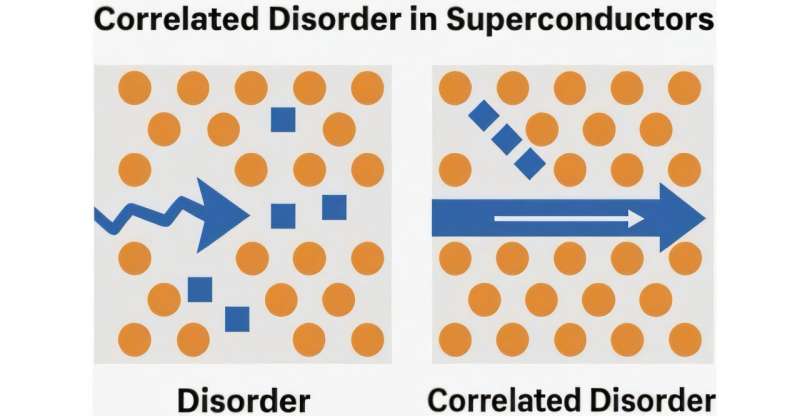Science
Researchers Unveil New Method to Enhance Superconductivity

An international team of scientists has unveiled a groundbreaking approach to enhance superconductivity by arranging defects within materials in a specific pattern. This research, published on July 24, 2025, in the journal Physical Review B, could pave the way for superconductors that function effectively without the need for extreme cooling, a significant advancement in the field of materials science.
Superconductivity allows electric current to flow through a material without any energy loss, a phenomenon that has immense practical applications. Currently, superconductors are vital in technologies such as MRI machines, where strong magnetic fields are generated. However, the majority of superconductors operate only at temperatures below -140 °C, which limits their widespread use. Researchers are actively seeking methods to increase operational temperatures and enhance stability.
The study involved physicists from the HSE MIEM Center for Quantum Metamaterials, collaborating with experts from MEPhI, MIPT, and the Federal University of Pernambuco in Brazil. They discovered that controlling the arrangement of defects—imperfections in a material’s crystal lattice—can lead to more stable superconductivity. Traditionally, defects, such as excess or missing atoms and impurities, hinder electron movement and weaken superconductivity. Instead of attempting to eliminate these defects, the researchers proposed a novel strategy: arranging them in a coordinated pattern, known as correlated disorder.
The concept of correlated disorder can be likened to a crowd of people moving in a complex but organized dance, as explained by Alexei Vagov, a professor at the HSE Tikhonov Moscow Institute of Electronics and Mathematics. He stated, “In superconductors, it turns out that this kind of order within disorder causes defects to actually enhance superconductivity.”
The researchers conducted simulations of a two-dimensional superconductor featuring various defect distributions. They found that when defects were organized rather than randomly scattered, superconductivity emerged simultaneously across the entire material as the temperature decreased. This immediate transition stands in contrast to the traditional two-stage development of superconductivity, where isolated regions first appear before connecting.
These findings hold significant promise for the creation of thin superconducting films that align closely with the model used in the study. By controlling defect placement during the synthesis of these films, scientists can test theoretical predictions and develop materials with tailored properties.
Vagov emphasized the potential implications of this research, stating, “Controlling the placement of defects at the microscopic level could enable the creation of superconductors that operate at much higher temperatures—potentially even at room temperature. This would transform superconductivity from a laboratory rarity into a technology used in everyday devices.”
The implications of this research are vast, with the potential to revolutionize various sectors, including energy transmission and high-speed computing. As scientists continue to explore the intricacies of superconductivity, this innovative approach could lead to practical applications that enhance technological capabilities worldwide.
For further reading, the detailed study can be found in the article titled “Spatial correlations in disorder: Impact on the superconducting critical temperature” by Vyacheslav D. Neverov et al. in Physical Review B.
-

 Health3 months ago
Health3 months agoNeurologist Warns Excessive Use of Supplements Can Harm Brain
-

 Health3 months ago
Health3 months agoFiona Phillips’ Husband Shares Heartfelt Update on Her Alzheimer’s Journey
-

 Science2 months ago
Science2 months agoBrian Cox Addresses Claims of Alien Probe in 3I/ATLAS Discovery
-

 Science2 months ago
Science2 months agoNASA Investigates Unusual Comet 3I/ATLAS; New Findings Emerge
-

 Science1 month ago
Science1 month agoScientists Examine 3I/ATLAS: Alien Artifact or Cosmic Oddity?
-

 Entertainment5 months ago
Entertainment5 months agoKerry Katona Discusses Future Baby Plans and Brian McFadden’s Wedding
-

 Science1 month ago
Science1 month agoNASA Investigates Speedy Object 3I/ATLAS, Sparking Speculation
-

 Entertainment4 months ago
Entertainment4 months agoEmmerdale Faces Tension as Dylan and April’s Lives Hang in the Balance
-

 World3 months ago
World3 months agoCole Palmer’s Cryptic Message to Kobbie Mainoo Following Loan Talks
-

 Science1 month ago
Science1 month agoNASA Scientists Explore Origins of 3I/ATLAS, a Fast-Moving Visitor
-

 Entertainment2 months ago
Entertainment2 months agoLewis Cope Addresses Accusations of Dance Training Advantage
-

 Entertainment3 months ago
Entertainment3 months agoMajor Cast Changes at Coronation Street: Exits and Returns in 2025









